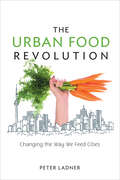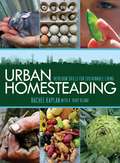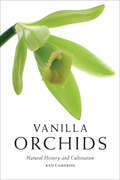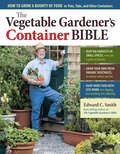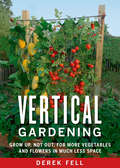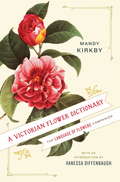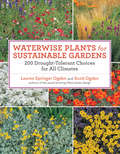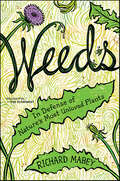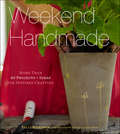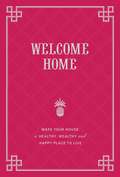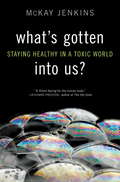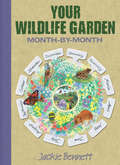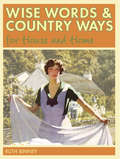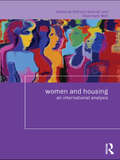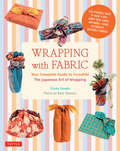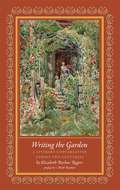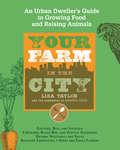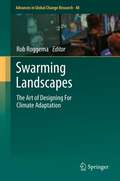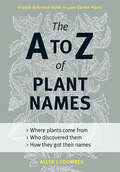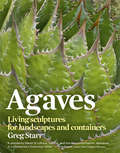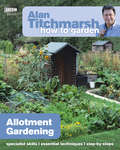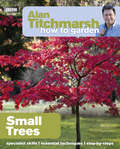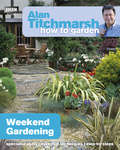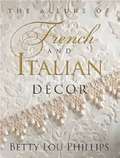- Table View
- List View
The Urban Food Revolution: Changing the Way We Feed Cities
by Peter LadnerOur reliance on industrial agriculture has resulted in a food supply riddled with hidden environmental, economic, and health care costs and beset by rising food prices. With only a handful of corporations responsible for the lion's share of the food on our supermarket shelves, we are incredibly vulnerable to supply chain disruption.The Urban Food Revolution provides a recipe for community food security based on leading innovations across North America. The author draws on his political and business experience to show that we have all the necessary ingredients to ensure that local, fresh sustainable food is affordable and widely available. He describes how cities are bringing food production home by:*Growing community through neighborhood gardening, cooking, and composting programs*Rebuilding local food processing, storage, and distribution systems*Investing in farmers markets and community supported agriculture*Reducing obesity through local fresh food initiatives in schools, colleges, and universities*Ending inner-city food desertsProducing food locally makes people healthier, alleviates poverty, creates jobs, and makes cities safer and more beautiful. The Urban Food Revolution is an essential resource for anyone who has lost confidence in the global industrial food system and wants practical advice on how to join the local food revolution.Peter Ladner has served two terms as a Vancouver City Councilor. With more than thirty-five years of journalistic experience, he is a frequent speaker on community issues and has a special interest in the intersection of food policy and city planning.
Urban Homesteading: Heirloom Skills for Sustainable Living
by K. Ruby Blume Rachel KaplanThe urban homesteading movement is spreading rapidly across the nation. Urban Homesteading is the perfect "back-to-the-land" guide for urbanites who want to reduce their impact on the environment. Full of practical information, as well as inspiring stories from people already living the urban homesteading life, this colorful guide is an approachable guide to learning to live more ecologically in the city. The book embraces the core concepts of localization (providing our basic needs close to where we live), self-reliance (re-learning that food comes from the ground, not the grocery store; learning to do things ourselves), and sustainability (giving back at least as much as we take). Readers will find concise how-to information that they can immediately set into practice, from making solar cookers to growing tomatoes in a barrel to raising chickens in small spaces to maintaining mental serenity in the fast-paced city environment. Full of beautiful full-color photographs and illustrations, and plenty of step-by-step instructions, this is a must-have handbook for city folk with a passion for the simple life.
Vanilla Orchids: Natural History and Cultivation
by Ken CameronWith more than 30,000 known species, orchids represent the largest family of plants. But only one genus has agricultural value—the Vanilla orchid. Leading orchid expert Ken Cameron covers the natural history of the world’s most popular flavor and fragrance and provides an introduction to the pollination, biology, structure, evolution, and diversity of Vanilla and related orchids. Vanilla Orchids also features methods for bean harvest, curing, and processing for enthusiasts who want to try it at home.
The Vegetable Gardener's Container Bible: How to Grow a Bounty of Food in Pots, Tubs, and Other Containers
by Edward C. SmithHarvest tomatoes on a patio, produce a pumpkin in a planter, and grow broccoli on a balcony! Best-selling author Ed Smith shows you everything you need to know to successfully create and care for an edible container garden, from choosing the right plants and selecting appropriate containers through controlling pests without chemicals and harvesting fresh vegetables. You&’ll discover that container gardening is an easy and fun way to enjoy summer&’s bounty in even the smallest of growing spaces.
Vertical Gardening: Grow Up, Not Out, for More Vegetables and Flowers in Much Less Space
by Derek FellThe biggest mistake gardeners make each season is starting out too big and then quickly realizing their large plot requires too much weeding, watering, and backbreaking labor. Vertical gardening guarantees a better outcome from the day the trowel hits the soil—by shrinking the amount of "floor" space needed and focusing on climbing plants that are less prone to insects, diseases, and animal pests.Notable author and gardener Derek Fell has tried and tested thousands of varieties of vegetables, flowers, and fruits and recommends the best plants for space-saving vertical gardening. His grow-up, grow-down system also shows which ground-level plants make good companions underneath and alongside climbing plants. Best of all, many of Fell's greatest climbers and mutually beneficial plants are available in seed packets in every local garden center.With a mix of DIY and commercially available string supports, trellises, pergolas, raised beds, skyscraper gardens, and topsy-turvy planters, the vertical garden system reduces work, increases yields, makes harvesting easier, and can be practiced in spaces as small as a container or a one-by-four-foot strip. Vertical Gardening features 100 color photos of the author's own vertical methods and showcases beautiful, troublefree perennials, shrubs, vegetables, annuals, and fruit perfect for this new, rewarding way to garden.
A Victorian Flower Dictionary
by Mandy Kirkby Vanessa Diffenbaugh"A flower is not a flower alone; a thousand thoughts invest it." Daffodils signal new beginnings, daisies innocence. Lilacs mean the first emotions of love, periwinkles tender recollection. Early Victorians used flowers as a way to express their feelings--love or grief, jealousy or devotion. Now, modern-day romantics are enjoying a resurgence of this bygone custom, and this book will share the historical, literary, and cultural significance of flowers with a whole new generation. With lavish illustrations, a dual dictionary of flora and meanings, and suggestions for creating expressive arrangements, this keepsake is the perfect compendium for everyone who has ever given or received a bouquet.From the Hardcover edition.
Waterwise Plants for Sustainable Gardens: 200 Drought-Tolerant Choices for all Climates
by Scott Ogden Lauren Springer Ogden“I can't imagine a designer or avid gardener who wouldn't want this on their bookshelf.” —Garden Design OnlineWaterwise Plants for Sustainable Gardens is a practical guide to the best 200 plants guaranteed to thrive in low-water gardens. Plant entries provide the common and botanical name, the regions where the plant is best adapted, growth and care information, and notes on pests and disease. This practical and inspiring guide includes a variety of plants, from trees to succulents, perennials to bulbs, all selected for their wide adaptability and ornamental value. Companion plants, creative design ideas, and full color photography make this guide a must-have resource for any sustainable gardener.
Weeds: In Defense of Nature's Most Unloved Plants
by Richard Mabey“[A] witty and beguiling meditation on weeds and their wily ways….You will never look at a weed, or flourish a garden fork, in the same way again.”—Richard Holmes, author of The Age of Wonder“In this fascinating, richly detailed book, Richard Mabey gives weeds their full due.”—Carl Zimmer, author of EvolutionRichard Mabey, Great Britain’s Britain’s “greatest living nature writer” (London Times), has written a stirring and passionate defense of nature’s most unloved plants. Weeds is a fascinating, eye-opening, and vastly entertaining appreciation of the natural world’s unappreciated wildflowers that will appeal to fans of David Attenborough, Robert Sullivan’s Rats, Amy Stewart’s Wicked Plants, and to armchair gardeners, horticulturists, green-thumbs, all those who stop to smell the flowers.
Weekend Handmade: More Than 40 Projects and Ideas for Inspired Crafting (Weekend Craft Ser.)
by Kelly Wilkinson&“Weekend Handmade provides instructions for quirky crafts that virtually anyone can do . . . Think hipster Martha Stewart&” (NPR Weekend Edition). In Weekend Handmade, author Kelly Wilkinson encourages readers to celebrate the joy of crafting, both for the satisfaction of making something by hand, and because the finished items serve as reminders of time taken to slow down and create—no matter the day of the week. The book is organized into three sections: &“Make&” offers projects to wear or decorate with; &“Grow&” presents projects inspired by gardens, fields, and farmer&’s markets; and &“Gather&” spotlights projects that enrich casual get-togethers. With clear, step-by-step instructions, every project in Weekend Handmade—from aprons, tablecloths, and marmalade to a memory box and a chandelier—can be completed in a few hours or over the course of a weekend. &“Think you can&’t make anything—or, more importantly, that you don&’t have the time to? Wilkinson&’s undowdy projects—luminarias, table decorations—are all designed to be completed in a couple of hours.&” —Entertainment Weekly
Welcome Home
by Rebecca DilibertoThis luxe little gift book holds the key to making a home harmonious. From the front door to the bedroom, every square inch of a dwelling can bring its occupants luck, and Welcome Home shows readers how. Compiled with vintage appeal, easy-to-peruse entries explain how to ward off negativity with dill, boost health with green accents in the kitchen, and more. This illustrated collection of superstitions and rituals gathered from across the globe and throughout the ages will help newlyweds, new home owners, feng shui fans, decorators, or those simply feeling down on their luck to conjure the health, wealth, and happiness they so richly deserve.
What's Gotten into Us? Staying Healthy in a Toxic World
by Mckay JenkinsDo you know what chemicals are in your shampoo? How about your cosmetics? Do you know what's in the plastic water bottles you drink from, or the weed killer in your garage, or your children's pajamas? If you're like most of us, the answer is probably no. But you also probably figured that most of these products were safe, and that someone--the manufacturers, the government--was looking out for you. The truth might surprise you.After experiencing a health scare of his own, journalist McKay Jenkins set out to discover the truth about toxic chemicals, our alarming levels of exposure, and our government's utter failure to regulate them effectively. The result of his two-year journey, What's Gotten into Us?, is a deep, remarkable, and empowering investigation into the threats--biological and environmental--that chemicals now present in our daily lives. It reveals how dangerous, and how common, toxins are in the most ordinary things, and in the most familiar of places: * Our water: Thanks to suburban sprawl and agricultural runoff, 97 percent of our nation's rivers and streams are now contaminated with everything from herbicides to pharmaceutical drugs. * Our bodies: High levels of hormone-disrupting chemicals from cosmetics, flame-retardants from clothing and furniture, even long-banned substances like DDT and lead, are consistently showing up in human blood samples. * Our homes: Many toxins lurk beneath our sinks and in our basements, of course, but did you know that they're also found in wall-to-wall carpeting, plywood, and fabric softeners? * Our yards: Pesticides, fungicides, even common fertilizers--there are enormous, unseen costs to our national obsession with green, weed-free lawns. What's Gotten Into Us? is much more than a wake-up call. It offers numerous practical ways for us to regain some control over our lives, to make our own personal worlds a little less toxic. Inside, you'll find ideas to help you make informed decisions about the products you buy, and to disentangle yourself from unhealthy products you don't need--so that you and your family can start living healthier lives now, and in the years to come. Because, as this book shows, what you don't know can hurt you.From the Hardcover edition.
Wildlife Garden month by month: Month-by-month (Month-by-Month)
by Jackie BennettThe Wildlife Garden; covers everything the gardener needs to know to cultivate and maintain a wildlife haven in their own garden, however small. There is a wealth of practical information and colour photographs on 'natural' gardening in a clear, easy-to-use, month-by-month format, allowing gardeners to find the advice they need instantly, when they need it. This title provides an introduction to the wild plants and creatures for each month, together with seasonal tips, tasks, checklists and detailed plant profiles. It offers easy-to-follow practical projects to create new habitats, such as making a wildlife pond, building a nest box, planning a herb bed, planting a summer meadow, and more.
Wise Words & Country Ways for House and Home
by Ruth BinneyContains generations of advice on simple ways to run an environmentally-friendly home, based around well-known, and not-so-well-known, sayings. Everyone is keen to reduce their carbon footprint, conserve resources, eat and live more healthily. Ruth Binney's fascinating collection of traditional wisdom shares how our forbears lived well within the resources available.
Women and Housing: An International Analysis (Housing and Society Series)
by Patricia KennettIn the context of contemporary economic, political, social and cultural transformations, this book brings together contributions from developed and emerging societies in Europe, the USA and East Asia in order to highlight the nature, extent and impact of these changes on the housing opportunities of women. The collection seeks to contribute to comparative housing debates by highlighting the gendered nature of housing processes, locating these processes within wider structured and institutionalized relations of power, and to show how these socially constructed relationships are culturally contingent, and manifest and transform over time and space. The international contributors draw on a wide range of empirical evidence relating to labour market participation, wealth distribution, family formation and education to demonstrate the complexity and gendered nature of the interlocking arenas of production, reproduction and consumption and the implications for the housing opportunities of women in different social contexts. Worldwide examples are drawn from Australia, China, Great Britain, Hong Kong, Japan, Spain, Sweden, Taiwan and the USA.
Wrapping with Fabric
by Etsuko YamadaLong before today's eco-friendly philosophy of "reduce, reuse, recycle" entered America's collective consciousness, furoshiki-the Japanese method of wrapping things with fabric-?ourished as a time-honored and practical art form. In Wrapping With Fabric, Etsuko Yamada-born into a long-line of furoshiki makers in Kyoto-explains the "one cloth, many uses" ideology behind the craft, the etiquette of color and the craft's fascinating history. From there, she shares the myriad ways in which a few basic techniques can transform a simple square of cloth into an elegant wrapper you can use to: Gift-wrap anything from books to flowers Bundle up a picnic Tote items ranging from wine bottles to yoga mats Use as a handbag or backpack Make into a pillow covering Create decorative coverings for vases, tissue boxes, and more A quiet reminder that opportunities for artistry are everywhere around you, Wrapping With Fabric makes it easy to bring a touch of grace and ingenuity to everyday life-and help preserve the environment, too.
Wrapping with Fabric
by Etsuko Yamada Kanji OkamotoWrap anything from a wine bottle to a yoga mat with this practical Japanese fabric-wrapping book.Long before today's eco-friendly philosophy of "reduce, reuse, recycle" entered America's collective consciousness, furoshiki--the Japanese method of wrapping things with fabric--?ourished as a time-honored and practical art form. In Wrapping With Fabric, Etsuko Yamada--born into a long-line of furoshiki makers in Kyoto--explains the "one cloth, many uses" ideology behind the craft, the etiquette of color and the craft's fascinating history. From there, she shares the myriad ways in which a few basic techniques can transform a simple square of cloth into an elegant wrapper. Use your folded fabrics to: Gift-wrap anything from books to flowers Bundle up a picnic Tote items ranging from wine bottles to yoga mats Use as a handbag or backpack Make into a pillow covering Create decorative coverings for vases, tissue boxes, and moreA quiet reminder that opportunities for artistry are everywhere around you, Wrapping With Fabric is the craft book that makes it easy to bring a touch of grace and ingenuity to everyday life--and help preserve the environment, too.
Writing the Garden: A Literary Conversation Across Two Centuries
by Elizabeth Barlow RogersGardening, more than most outdoor activities, has always attracted a cult of devotedly literate practitioners; people who like to dig, it would appear, also like to write. And many of them write exceedingly well. In this thoughtful, personal, and embracing consideration of garden writing, garden historian Elizabeth Barlow Rogers selects and discusses the best of these writers. She makes her case by picking delightful examples that span two centuries, arranging the writers by what they did and how they saw themselves: nurserymen, foragers, conversationalists, philosophers, humorists, etc. Her discussions and appreciations of these diverse personalities are enhanced and supported by informed appraisals of their talents, obsessions, and idiosyncrasies, and by extensive extracts from their writings. Rogers provides historical background, anecdotal material, and insight into how these garden writers worked. And wherever appropriate, she illustrates her story with images from their books, so you can not only read what they wrote but also see what they were describing. Since gardens are by their very nature ephemeral, these visual clues from the pages of their books, many reproduced in color, are as close as we will come to the originals. What makes Writing the Garden such a joy to read is that it is not simply a collection of extracts, but real discussions and examinations of the personalities who made their mark on how we design, how we plant, and how we think about what is for many one of life's lasting pleasures. Starting with "Women in the Garden" (Jane Loudon, Frances Garnet Wolseley, and Gertrude Jekyll) and concluding with "Philosophers in the Garden" (Henry David Thoreau, Michael Pollan, and Allen Lacy), this is a book that encompasses the full sweep of the best garden writing in the English language. Writing the Garden is co-published by the New York Society Library and the Foundation for Landscape Studies in association with David R. Godine, Publisher.
Your Farm in the City: An Urban Dweller's Guide to Growing Food and Raising Animals
by The Gardeners of Seattle Tilth Lisa TaylorThe most complete book on urban farming, covering everything from growing organic produce and raising chickens, to running a small farm on a city lot or in a suburban backyard.Eating locally and growing one's own food is a rapidly evolving movement in urban settings - Hantz Farms in Detroit has transformed 70 acres of abandoned properties into energy-efficient gardens, and Eagle Street Rooftop Farm, a 6,000-foot vegetable farm in Brooklyn, New York, yields 30 different kinds of produce, while private square-foot farms are cropping up in cities all over the country.Created by Lisa Taylor and the gardeners of Seattle Tilth, Your Farm in the City covers all of the essential information specific to gardening and farming in a city or town. Clear, easy-to-follow instructions guide and inspire even the most inexperienced urbanite in how to grow and harvest all types of produce, flowers, herbs, and trees, as well as how to raise livestock like chickens, ducks, rabbits, goats, and honeybees. Important information particular to gardening in a city or town is included, such as planning and maximizing limited space, building healthy soil, managing irrigation, understanding zoning laws, outwitting urban pests, and being a considerate farming neighbor. With 100 two-color instructional illustrations throughout and dozens of vital resources, Your Farm in the City is the most practical, comprehensive, and easy-to-follow guide to the burgeoning trend of urban farming.
Swarming Landscapes
by Rob RoggemaThis book advocates a fresh approach to planning that anticipates, rather than reacts to, the changes in climate currently in process. Today's spatial planning procedures rely on historical evidence instead of preparing for factors that by definition lie in the future, yet which are relatively uncontroversial: shortages of water, sea level rise and rises in average temperatures being but three examples. Arguing for more flexibility, the contributors view 'complexity' as the key to transforming the way we plan in order to better equip us to face uncertainties about our future environment.
The A to Z of Plant Names: A Quick Reference Guide to 4000 Garden Plants
by Allen J. CoombesBotanical names can be baffling to even the most experienced gardener. But a plant's botanical name is more than just a handy label—it can tell a plant's country of origin, the shape of its leaves, the color of its petals, and much more. The A to Z of Plant Names clears the confusion and allows every gardener to name plants with confidence. This comprehensive yet handy guide features the botanic names of the plants that gardeners really grow. Additional information includes suggested pronunciation, the common name, the derivation of the scientific name, the number of species currently accepted, the type of plant and the distribution. The A to Z of Plant Names helps demystify names, provides readers with the intriguing background information to naming conventions, and empowers gardeners everywhere to feel confident about naming plants.
Agaves: Living Sculptures for Landscapes and Containers
by Greg StarrGardeners and garden designers are having a love affair with agaves. It's easy to see why—they're low maintenance, drought-tolerant, and strikingly sculptural, with an astounding range of form and color. Many species are strikingly variegated, and some have contrasting ornamental spines on the edges of their leaves. Fabulous for container gardening or in-the-ground culture, they combine versatility with easy growability. In Agaves, plant expert Greg Starr profiles 75 species, with additional cultivars and hybrids, best suited to gardens and landscapes. Each plant entry includes a detailed description of the plant, along with its cultural requirements, including hardiness, sun exposure, water needs, soil requirements, and methods of propagation. Agaves can change dramatically as they age and this comprehensive guide includes photos showing each species from youth to maturity—a valuable feature unique to this book.
Alan Titchmarsh How to Garden: Allotment Gardening (How to Garden #32)
by Alan TitchmarshAn allotment can be a source of abundant fresh fruit and vegetables for the home, as well as an oasis of calm for all the family to enjoy, but taking one on and learning how to grow your own can be an intimidating prospect. Alan Titchmarsh makes allotment gardening easy by explaining how to get the most from your plot with easy-to-follow, practical information and advice on what to grow, when to harvest and how to store your produce.* How to assess your plot and work with what you've got * Advice on layout and crop rotation * Expert guidance on care and maintenance * Directory of vegetables, fruit and herbs * Seasonal calendar of what to do when
Alan Titchmarsh How to Garden: Small Trees (How to Garden #30)
by Alan TitchmarshFew elements add interest to a garden better than a well-placed tree, and even small gardens can accommodate one. But trees are long-term investments, so it's worth knowing exactly what you want before you plant. Here Alan Titchmarsh guides us through the selection and planting processes, plus how to look after trees to ensure optimum performance and maximum impact. * Garden design ideas and where to plant trees * Practicalities of location and aspect * Ornamental effects for all seasons * Pests, tree diseases and problems * Illustrated gallery of recommended trees
Alan Titchmarsh How to Garden: Weekend Gardening (How to Garden #29)
by Alan TitchmarshWe all aspire to a beautiful garden that suits our lifestyle, but it can be hard to keep on top of the day-to-day care that gardens often require to look their best. Perfect for those who struggle with the workload, who want a space to relax in but aren't especially green-fingered, or for those are simply too busy to get stuck in, Weekend Gardening shows how to create an achievable garden that lives up to your dreams with just a few hours of work a week.* Explains the basic principles of labour-saving garden design * Practical gardening projects that can be completed in a weekend* Recommended easy-care plants * Solutions for difficult sites, including tricky soil types * Quick-reference seasonal tasks
The Allure Of French And Italian Decor
by Betty Lou Phillips"The furnishings of France enchant the eye, Italian pieces sing to the soul." --Betty Lou Phillips, ASID <p><p> France and Italy have long been the go-to spots for fashionistas, serious foodies and design mavens. Rich patinas, satisfying earthen hues and myriad natural materials--translate into timeless, unabashedly elegant yet livable rooms appropriate for our times. Award-winning designer Betty Lou Phillips shows how the best from two European countries combine to create la dolce vita--the good life. <p><p> Award-winning designer and best-selling author, Betty Lou Phillips is a professional member of the American Society of Interior Designers. With projects from New York to California, her work has been featured in countless magazines, as well as in her numerous home design books on French and Italian style. Interiors by Design--her 13th design book-is the ultimate guide to home décor. Additionally, she has appeared on the Christopher Lowell Show and the Oprah Winfrey Show. She lives in Dallas, Texas. Betty Lou Phillips is the author of Emily Goes Wild!, an illustrated children's book, and co-author of The Night Before Christmas in Paris. Later this year Gibbs Smith Publisher will release her Night Before Christmas in New York and Night Before Christmas in Texas.
